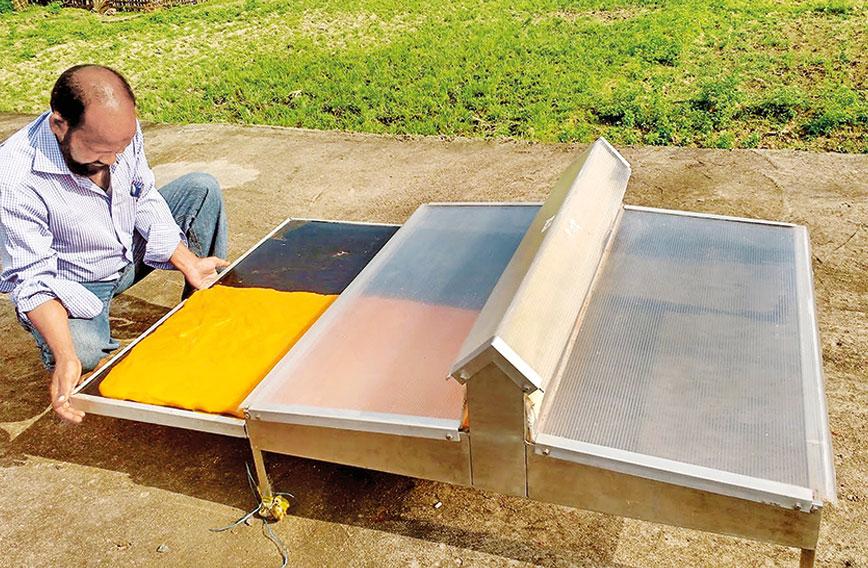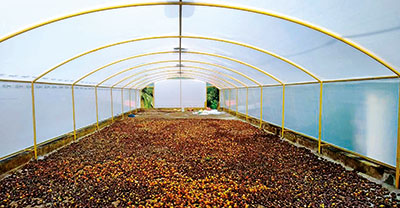
In search of the hybrid dryer to beat the monsoon
Shree Padre, Kasargod
During Covid times, when farmers couldn’t take their bunches of bananas to markets, a campaign was launched to encourage them to convert the bananas into flour at home instead.
A very easy method was found for converting raw bananas — of any variety — into flour. Nutritionally, banana flour is far superior to cereal and pulses flour. Its low glycemic index makes it suitable for diabetics too. It was a good idea for which a market seemed to exist. Many farmers responded enthusiastically to the campaign.
But, like all great ideas, this one too came with a hitch. The bananas had to first be dried before being ground into flour. It was monsoon time. In banana-growing areas, where it rains for four months of the year, solar dryers are of no use. With inclement weather due to climate change becoming a reality, dryers have become an essential tool for farmers. Even in low rainfall areas, unpredictable showers are now a regular feature.
Even as most farmers struggled with this challenge, those in one district, Uttara Kannada, didn’t seem to have a problem. The district has 5,000 dryers, the highest in Karnataka. For 20 years farmers have been using dryers. Initially they bought dryers which ran on biomass and then, as power supply became less erratic, they started buying electric dryers. The banana flour movement was a big success there.
Broadly, there are three types of dryers: electric, biomass (firewood) and solar. There are manufacturers of such dryers across the country since industry also uses them. But in the agricultural sector, where dryers are really needed, uptake has been slow.
Solar dryers don’t require recurring expenditure. The quality of the farm produce dried is good, retaining aroma and colour. But in areas of heavy rainfall or prolonged monsoon, solar dryers cannot be used for four months. And this is exactly the time farmers need dryers the most.
What is really needed are hybrid dryers which run on both solar and electricity and biomass. Although such dryers are available, their inefficiency hasn’t made them popular with farmers. But here are some examples of dryers that have become popular.
In coastal Karnataka, arecanut is the main cash crop. It needs 50 days to dry in the sun. But if there is unseasonal rain, transferring the crop quickly from the drying yard is laborious and sometimes impossible. So, a few farmers came up with their own crudely designed low-cost solar dryer which resembles a tiled roof. A sloping scaffolding is built, and an ultraviolet stabilized transparent polyethylene sheet is erected over it with one or two doors for entry.
 This low-cost solar dryer became so popular that there are very few farmers who don’t own one in this coastal belt. Sensing demand, local agencies began building and advertising such dryers with mild steel supporting structures and UV sheets of good quality. These dryers are generally dome-shaped and cost about Rs100 per square foot.
This low-cost solar dryer became so popular that there are very few farmers who don’t own one in this coastal belt. Sensing demand, local agencies began building and advertising such dryers with mild steel supporting structures and UV sheets of good quality. These dryers are generally dome-shaped and cost about Rs100 per square foot.
About 50 agencies in Dakshina Kannada construct such dryers for arecanut farmers, says MuralidharaShastry, proprietor of Sneha Traders who constructs such dryers. The district has probably thousands of such locally made dryers. The professionally constructed, built on-site ones last for seven or eight years whereas do-it-yourself structures have a life span of three to four years. Information about such models is spread by YouTubers.
Small versus big
However, large dryers like these are not suited for drying fruits or value-added food products hygienically. A domestic, smaller dryer is ideal for such tasks.
Many crops are harvested during the monsoon. Among them are nutmeg, jackfruit, banana and minor fruits like bilimbi, carambola, fig and sapota. Farmers can dry surplus produce and consume it themselves. Or they can sell their dehydrated products locally.
During the banana flour campaign, it was found that even some of the KrishiVijnanKendras (KVK) did not have a single dryer. While seminars on “doubling the income of farmers” have increased, KVKs not having an essential component like a dryer exposes the fallacy of the government’s avowed agenda.
It is the KVKs that need to create awareness among local farmers on how to augment their income using dryers. By grooming a few model farmers, word can spread. Unfortunately, instances of such efforts are few.
Some KVKs in Wayanad, Kannur and Kerala Agriculture University’s Vellayani campus in Thrissur have tried to help. Farmers can fix an appointment and take their surplus vegetables or fruits for processing to these centres which convert them into dehydrated or value-added products using their own machinery and staff. A nominal charge is sought for this service. The dryer is the main machine used. Such work also creates awareness among farmers on how to generate income from surplus farm produce.
Another example is from Sagar in Shimoga district in Karnataka. With four months of monsoon rain, this is an area with heavy precipitation. Apart from arecanut, the main crop, farmers grow coconut, banana, pineapple and many minor fruits.
In Sagar, Nagendra Sagar and his wife, Vanishree, who are farmers and entrepreneurs, are helping small farmers dehydrate their produce and earn an income. They dehydrate pineapple, banana, fig, and other fruits and vegetables on their farm. Vanishree has been designated the district resource person for the ODOP (One District One Product) project by the agriculture department. The couple are dynamic social activists too.
Invaluable asset
“A good dryer is an invaluable asset and essential for lower middle-class farmers in Shimoga. If they use it wisely, they can recover their investment in just three years,” says Nagendra. They are helping farmers start micro-ventures with an investment of just Rs2-3 lakh. Nagendra says some farmers invested just Rs1 lakh.
The couple visits small farmers and then invites them to see their own ventures. They handhold farmers and instil confidence in them. When small farmers make some headway, Nagendra writes about it and posts it on his Facebook page to give them more exposure.
As a result, in the past year and a half, some 60 electric dryers have been bought by small farmers. “Seventy-five percent of farmers bought dryers to increase their income. Unlike biomass and solar dryers, the electric dryers provide uniform heat. You don’t have to change the position of the trays and the quality of produce is also good,” says Nagendra.
Most farmers have opted for dryers with 50-kg capacity which cost about Rs1 lakh. About 40 to 45 farmers have set up small coconut oil extraction units, using their dryers. They have invested in small oil extractors that run on 2 HP power and produce about 12 litres of oil per hour.
Around 15 families are using the dryer to make jackfruit papad and other types of papad. Some are dehydrating banana, fig, and local minor fruits.
The Sagars organize buyer-seller meetings too. “Discussion with entrepreneurs instils confidence in these farmers who are otherwise hesitant and prefer to remain inside their shell,” says Nagendra.
Uttara Kannada district seems to be the frontrunner in use of dryer technology. Arun Kumar Joshi, owner of Joshi Dryers, is a farmer himself. His company must have constructed nearly 800 dryers in the past 20 years which were bought by farmer families to keep arecanut moisture-free and fresh during the monsoon months.
Post-monsoon, when the dryers were lying idle, housewives started using them for dehydrating jackfruit and bananas to make papad and chips. The advent of online marketing through social media made it easier for them to sell their products.
Today, dozens of housewives in Uttara Kannada, otherwise shy and stuck to their kitchens, are promoting their products through Facebook and other social media platforms. They receive orders online and dispatch their products by post or courier. Many housewives are now earning an income by making pickles, jackfruit chips, papad and dried banana — a great example of women’s empowerment through a simple technology.
Comments
-

Dr Srikanth - April 21, 2023, 5:52 a.m.
Informative! Thanks. This info must reach many more farmers & homemakers...
-

Raj - April 20, 2023, 11:22 a.m.
As an action policy piece this is excellent. While adequate and timely water for production is critical; getting rid of water to store the produce is absolutely critical for the farmers. Thailand other East Asian countries have championed the drying technology to improve farmer's income, marketability and even impacted nutrition. Liked the insight on 'micro dryers' - a much needed investment area. Continued innovation, research and commercialization of low cost dryers customized to various needs and climate is warranted.





